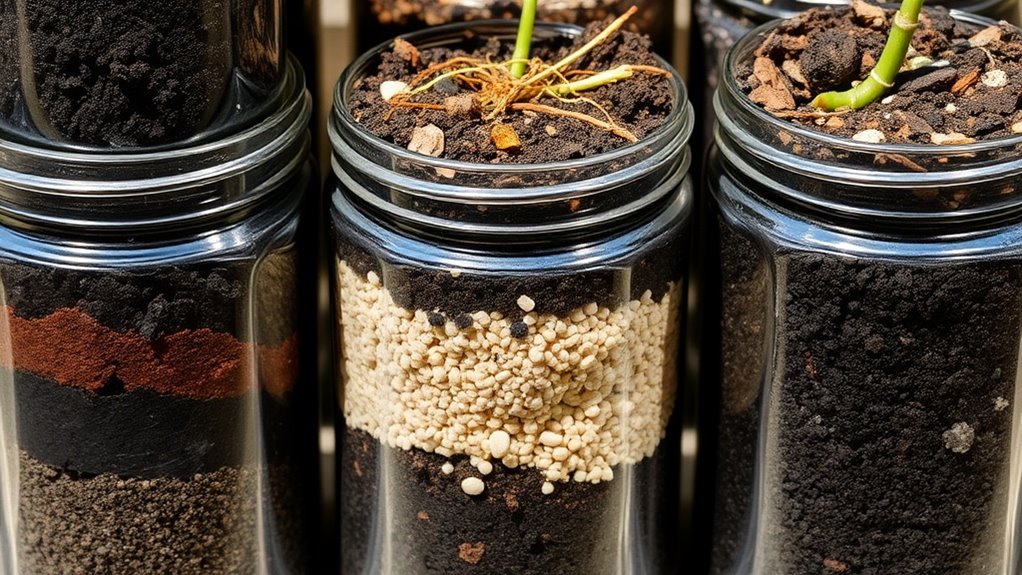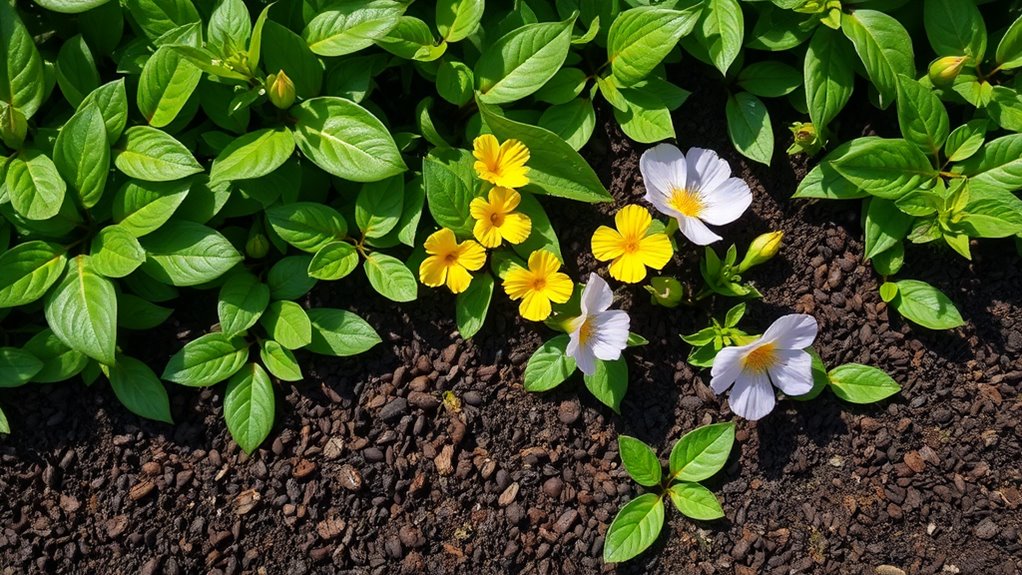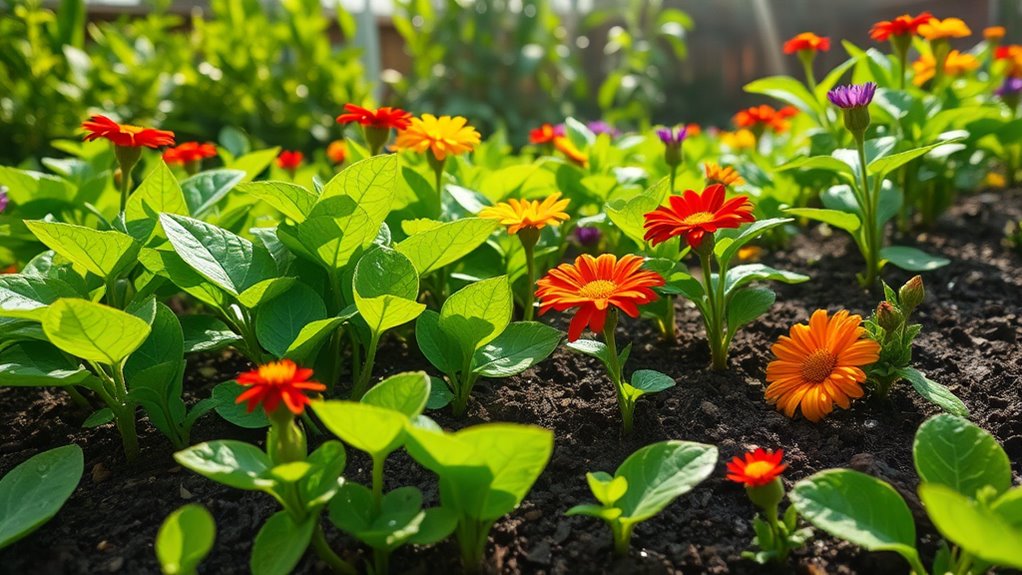How to Know If Your Soil Is Good or Bad – The Easy Way
To know if your soil is good or bad, evaluate its composition, texture, pH levels, and drainage. Check for moisture retention and nutrient levels by observing plant health, color, and growth. Dark, crumbly soil with earthworms signals fertility, while poor drainage or compact layers can harm roots. Conducting a soil test can reveal essential information and identify any deficiencies or toxicities impacting plant health. There’s more to uncover about enhancing your soil quality.
Understanding Soil Composition
How can you determine the quality of your soil? Start with a thorough soil check to analyze its composition.
Essential components include minerals, organic matter, water, and air.
Each element plays a significant role in nutrient availability and microbial activity.
For instance, a high organic matter content often indicates fertile soil, while excessive sand or clay can hinder water retention and root growth.
Testing pH levels also reveals acidity or alkalinity, which affects nutrient uptake. Additionally, soil testing can help identify specific deficiencies or imbalances, enabling targeted amendments for optimal plant health.
Assessing Soil Texture
To determine your soil’s viability, you need to assess its texture, which greatly impacts water retention and nutrient availability.
Various texture testing methods, such as the jar test or ribboning technique, can provide valuable insights into your soil’s composition. Additionally, understanding soil signs can help you identify any underlying issues that may affect your garden’s health.
Soil Composition Importance
What factors determine the quality of your soil’s texture?
Soil texture, defined by the proportions of sand, silt, and clay, affects drainage, nutrient retention, and aeration.
A balanced mix promotes healthy root development, while extreme textures—like heavy clay or sandy soil—can hinder growth.
For instance, clay retains moisture but can suffocate roots, whereas sandy soil drains quickly, leading to nutrient leaching.
Understanding your soil’s texture helps you make informed decisions about amendments and plant selection.
Therefore, examining soil composition isn’t just a step; it’s essential for fostering a thriving garden or landscape that meets your specific needs.
Texture Testing Methods
Have you ever wondered how to accurately assess your soil’s texture?
Understanding your soil’s texture is essential for effective gardening.
Here are three texture testing methods you can use:
-
Ribbon Test: Take a moist soil sample and squeeze it into a ribbon. The length and thickness indicate the texture, with longer ribbons suggesting clay content.
-
Jar Test: Mix soil with water in a jar and let it settle. Observe the layers to determine the proportions of sand, silt, and clay.
-
Feel Test: Rub soil between your fingers to identify its grit or smoothness, helping gauge its texture.
Checking Soil Ph Levels
How can you determine if your soil’s pH is suitable for healthy plant growth? Start by using a pH meter or soil test kit, both of which are readily available.
Ideally, most plants thrive in a pH range of 6.0 to 7.5. If your results fall outside this range, consider amending your soil. For acidic soils, adding lime can raise pH, while sulfur can lower it in alkaline soils. Regular testing—at least every few years—ensures you’re maintaining ideal conditions. Additionally, soil testing helps to identify nutrient deficiencies that could impact plant health and growth.
Evaluating Drainage and Moisture Retention
To evaluate your soil’s drainage and moisture retention, start with a soil drainage test to measure how quickly water moves through it. This will help you identify whether your soil retains too much water or dries out too quickly. Additionally, evaluating moisture retention will give you insights into how well your soil supports plant growth. Incorporating natural techniques can further enhance the soil quality, making it more suitable for plants.
Soil Drainage Test
When examining the quality of your soil, evaluating its drainage capabilities is essential for understanding moisture retention.
A simple soil drainage test can reveal how well your soil absorbs water, which is vital for plant health.
Here’s how to conduct it:
- Dig a Hole: Create a hole about 12 inches deep and 12 inches wide.
- Fill with Water: Fill the hole with water and let it drain completely.
- Measure Drainage Time: Refill the hole and time how long it takes for the water to drain.
Assessing these results will help you determine if your soil drains adequately, guiding your gardening decisions.
Moisture Retention Assessment
After examining your soil’s drainage capabilities, it’s important to evaluate how well it retains moisture. You can assess moisture retention through texture, structure, and organic matter content. Here’s a quick reference table to help you gauge your soil’s moisture retention potential:
| Soil Type | Moisture Retention Capacity | Ideal Crops |
|---|---|---|
| Sandy | Low | Cacti, Succulents |
| Loamy | Moderate | Vegetables, Flowers |
| Clay | High | Rice, Certain Grains |
| Silty | Moderate to High | Corn, Fruits |
| Peaty | Very High | Blueberries, Ferns |
Evaluate these factors to determine your soil’s moisture retention.
Identifying Nutrient Levels
How can you determine if your soil has the right nutrients for healthy plant growth?
You’ll need to conduct a soil test, which provides a clear picture of nutrient levels.
Here are three essential nutrients to focus on:
- Nitrogen: Vital for leaf growth; low levels can stunt plant development.
- Phosphorus: Important for root and flower growth; deficiency leads to poor flowering.
- Potassium: Enhances overall plant health; inadequate potassium can result in weak stems.
Additionally, understanding soil myths can help you make informed decisions about soil management for better plant health.
Inspecting Soil Color and Structure
Soil color indicates organic matter content and drainage. Dark brown or black soil usually suggests high organic material, while pale colors may signal poor fertility.
Structure refers to how soil particles clump together. Well-structured soil has a crumbly texture, promoting air circulation and water retention. Compacted or dense soil restricts root growth and water infiltration.
To assess your soil, dig a small hole. Observe the color and feel the texture; these factors directly influence plant health and nutrient availability, serving as essential indicators of soil quality. Additionally, assessing soil health is crucial for determining the best plants to grow in your garden.
Observing Plant Growth and Health
Have you noticed your plants thriving or struggling in your garden?
Observing their growth and health can reveal much about your soil quality.
Healthy plants typically display vibrant colors, robust growth, and resilience to pests.
In contrast, struggling plants may exhibit stunted growth and discoloration.
Here are three key indicators to watch for:
- Leaf Color: Yellowing leaves can indicate nutrient deficiencies.
- Growth Rate: Slow growth may suggest poor soil structure or compaction.
- Root Development: Healthy roots should be white and spread out; dark, mushy roots signal overwatering or disease.
Additionally, incorporating natural soil preparation techniques can further enhance your soil health and plant vitality.
Assess these factors to gauge your soil’s condition effectively.
Conducting a Soil Test
To truly understand your soil’s quality, conducting a soil test provides definitive insights beyond just observing plant health.
Start by collecting samples from various locations in your garden to guarantee representation.
Use a soil testing kit or send samples to a professional lab for accurate results.
The test will reveal pH levels, nutrient content, and organic matter, which are vital for plant growth.
Analyze the findings to identify deficiencies or toxicities that may affect your plants.
By knowing your soil’s specific needs, you can make informed amendments, enhancing your garden’s productivity and overall health.
A soil test is essential for successful gardening.





